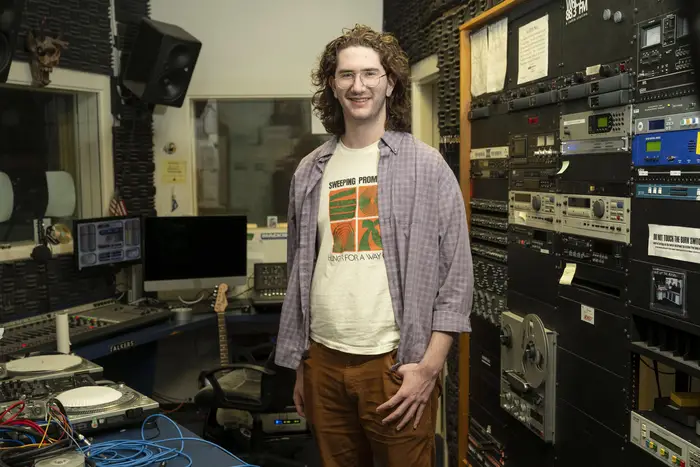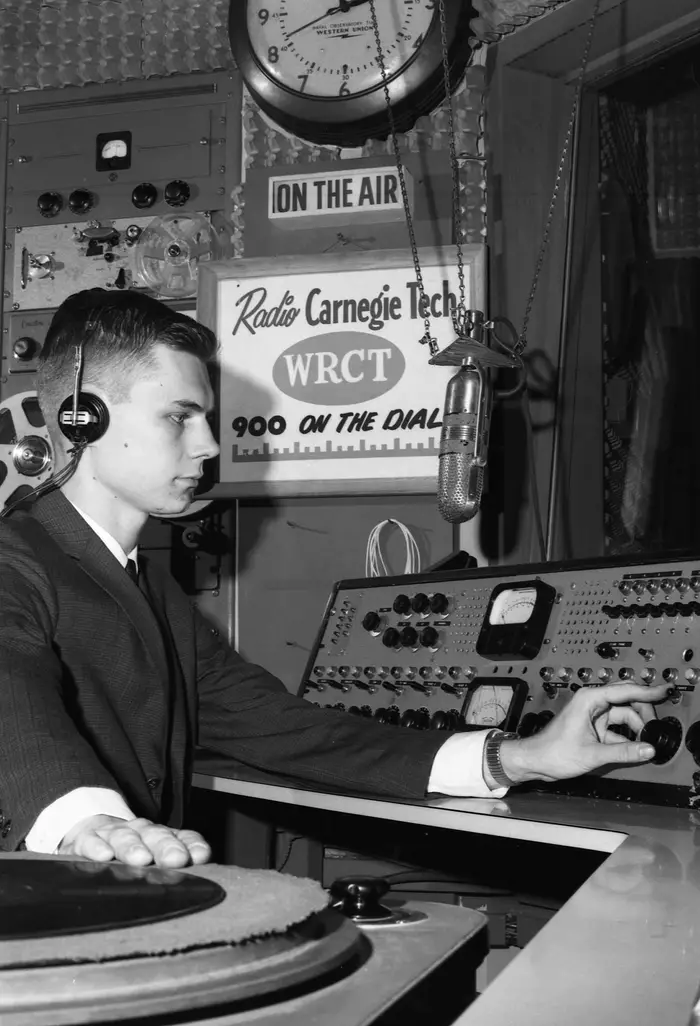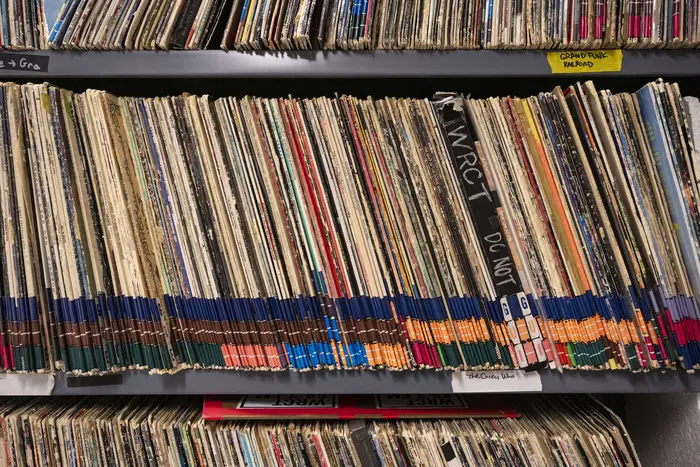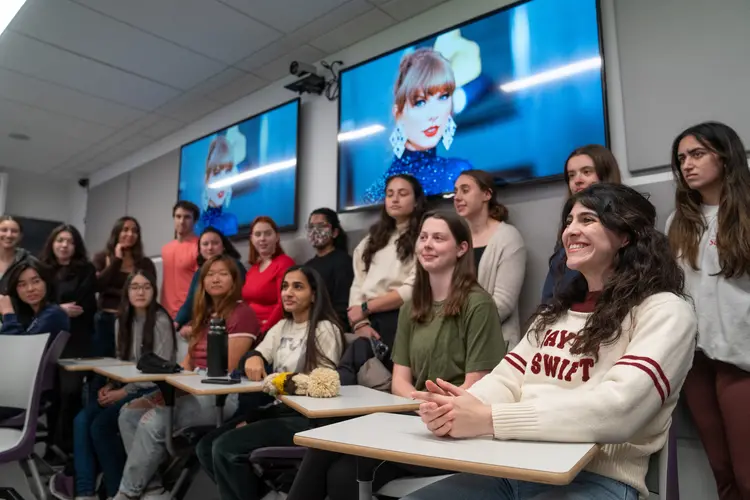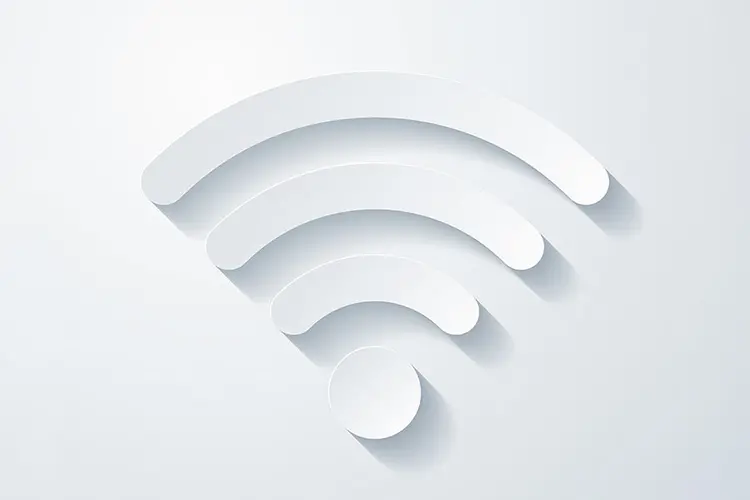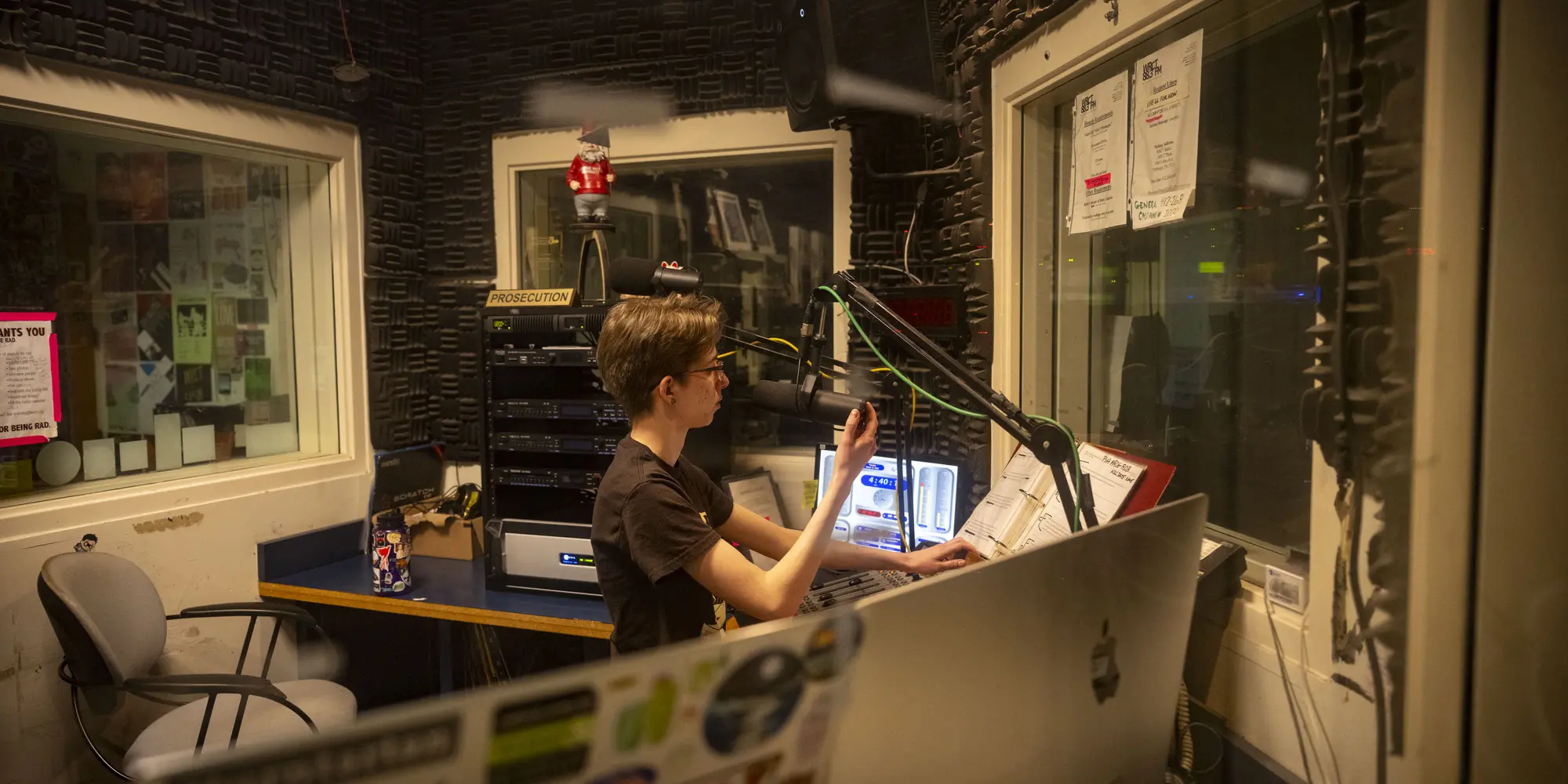
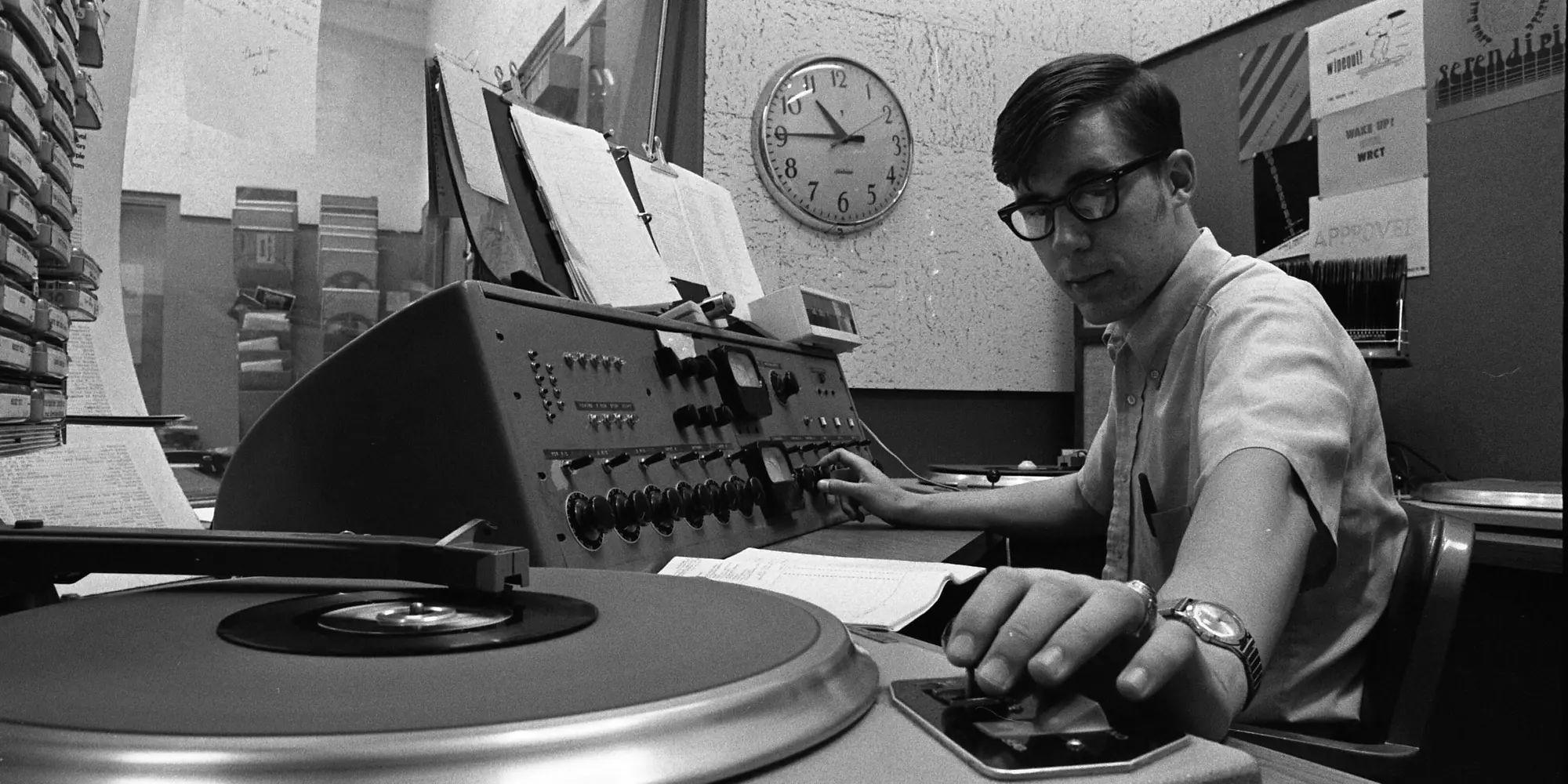
Student-run Radio Station WRCT Celebrates 75 Years of Music Discovery
Media Inquiries
From its home in the Cohon University Center basement, past the post office mailboxes and the silver frozen “Sophomore Faces”(opens in new window), WRCT’s speakers blare the tune of the moment and draw visitors toward windows adorned with album covers, concert flyers and the station’s call letters in large blue serif vinyl letters — except for the R, which is a Sesame Street coloring book page.
“The quirkiness of the station is something that I value a lot. We’re very much a no-judgment space, you play whatever you want; that’s awesome,” said Aditi Raghavan, a master’s student in electrical and computer engineering, serving as staff representative in her sixth year at WRCT. “We're lucky to have such a nice, proper space that imbues a sense of community.”
Embracing ‘the weird’ for 75 years
Whether it’s playing noise, bagpipes, reggae — or anything in between — freeform independent radio station WRCT(opens in new window) at 88.3 FM marks its 75th year broadcasting from Carnegie Mellon University this year.
To celebrate, the station is hosting its annual Spring Dance Party on April 10(opens in new window) at Spirit in Pittsburgh’s Lawrenceville neighborhood and an alumni gathering from 1 to 3 p.m. April 13 in the Cohon University Center during Spring Carnival.
“We embrace the weird and celebrate niche genres and artists,” said general manager Lukas Glist, a senior studying materials science and engineering. “There’s a very human element to radio that is lost in the Spotify algorithms. We’re not trying to be generic, we’re trying to be weird in all the ways that we can, and be widely appealing in a noncommercial way.”
The station, or “Radio Carnegie Tech” when it began in 1949(opens in new window), is also celebrating the 50th anniversary(opens in new window) of its move to FM(opens in new window) in 1974 from the AM dial, allowing it not only to reach everyone on CMU’s campus, but also serve as a community broadcaster in the Pittsburgh region. Now, the station has a 15-mile broadcast reach on terrestrial radio and beyond, due in part to the online livestream(opens in new window), which became vital for the station during the COVID-19 pandemic.
Inside the DJ booth
Alongside station walls covered in stickers, promo photos and music posters, program logs immortalized with a masking tape label commemorate the period when the pandemic prevented WRCT from broadcasting live from its studios from March 18 to Sept. 7, 2020. While the studios were off limits, the station maintained its 24/7 schedule through remote broadcasts and automated systems, technologies WRCT already had in place. Since then, the station allows some DJs to host shows remotely, but new DJs, especially students, are still required to start shows in-person.
Now, Glist said, about half of the time between 10 a.m. and 10 p.m. someone is inside the DJ booth at the station.
“College radio is a very niche thing that self-selects people who are interested in music, interested in talking about it, and interested in debating it,” he said. “A radio station has rigid functions it must do, but beyond putting music on the airwaves, it’s fun to see what people do with it.”
Those functions include things like understanding the FCC regulations and specifications to soon replace the 30-year-old physical antenna(opens in new window) on top of Warner Hall that is near the end of its lifespan, as Hazel Cline, chief engineer and a senior studying mechanical engineering, has been researching.
“All the effort keeping us on the air is done by students, it’s not done by anyone else,” Cline said.
How does radio stay relevant?
Over the years, no matter the technology or the music, WRCT has retained the creativity and personality that will help continue to keep it relevant and celebrating future anniversaries, said Larry Berger, who worked at the station as a CMU student from 1979-83, when he graduated with degrees in chemical engineering and engineering and public policy.
“Most radio stations are studied and designed so that any time you tune in, you're going to get this exact same experience and it’s tightly controlled,” said Berger, student mentor and creator and host of Saturday Light Brigade(opens in new window), which airs on the station. “At WRCT, you're going to have a lot of variability to what you hear. That is part of the charm of it, and what makes it fun to listen to and work with.”
WRCT can navigate the future by understanding and reflecting changes “looking for niches in the community that matter,” Berger said, especially the ones that only the radio station, as a live, ephemeral and creative outlet can provide.
“The music we play matters, and if the shows are done well, they expose other people to new ideas,” he said.
Students celebrating music
In addition to the station’s role broadcasting Buggy(opens in new window) for Spring Carnival, the staff plan annual events such as Anatomy of the Ear(opens in new window) in the fall, where DJs choose a single genre to play in hour-long blocks, and Massive Music Weekend(opens in new window) in the spring, where they choose a single artist — including live bands performing in the studio — in similar half-hour blocks back-to-back.
Glist called both “celebrations of music” that help recruit students thanks to the energy they create in the station’s underground lair, like the spring event his junior year when he thought he would be alone for his 2:30 to 4 a.m. timeslot.
“Instead, there were at least five other people who stuck with me as the last person for the marathon, and I felt very supported by that,” he said.
Glist, who joined the staff in 2020 as a first-year student on a chat server thanks to the pandemic, served as record librarian his sophomore year and hosted a “Record Roulette” show.
Even though many DJs broadcast digital music, the show took advantage of the station’s nearly 80,000 vinyl records and CDs — the weight of which is a major reason why WRCT is in the basement of the University Center rather than an upper floor, Glist said.
“We’re trying to pare down the rock genre, because rock is like two-thirds of the room as one of our catch-all genres, so we recently added soul,” he said.
The library door includes a sign warning that guests (who might have actual sticky fingers for the station’s copy of “Sticky Fingers”) aren’t allowed inside without a staff member. New music is added frequently, after DJs play and review albums from the bins that either come from promoters or store credit from underwriter Attic Records in Millvale.
Learning outside the classroom
Steve Auterman, a 1993 graduate from the School of Architecture who hosts a blues show on the station and has mentored students since 2017, said WRCT has endured as a hopeful promise.
“We deliver on our half of our promise and say we're going to show up every day, we're going to do our work and figure out what is good entertainment, and what is worth listening to,” he said. “If we’re good and lucky, in that order, then we will have people who come back again and again … they get to fulfill the other half of the promise.”
Unlike most college radio stations that are open only to students, community members are bridging the gap hosting shows where previously more student-DJs joined the staff before the declining availability and popularity of terrestrial radio, Auterman said.
“For WRCT specifically, it’s an opportunity for students to come together, learn about things that they’re just discovering or discovering more deeply, and that’s what a university is all about,” he said. “And radio is one way to do that that’s not in the classroom.”
